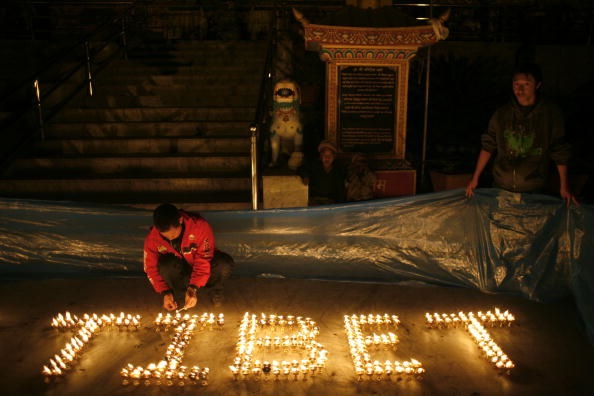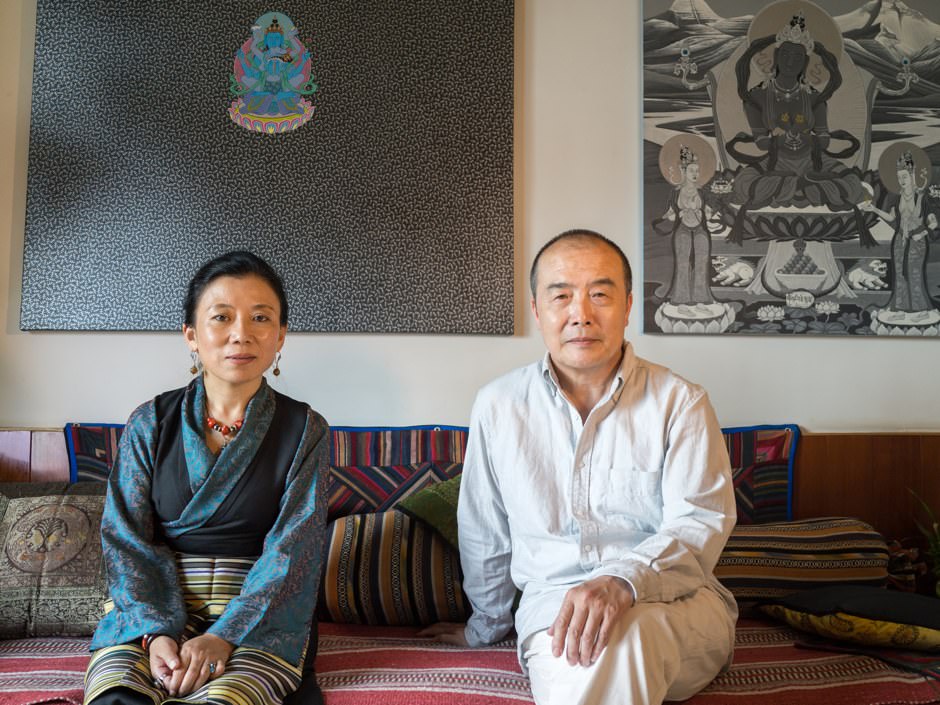In recent months, China has been beset by growing ethnic violence. In Tibet, 125 people have set themselves on fire since the suppression of 2008 protests over the country’s ethnic policies. In the Muslim region of Xinjiang, there have been a series of attacks by militants against Chinese rule; on July 28, the government reported that dozens of Uighur and Han Chinese were killed by knife-wielding assailants and police, who fired into the crowd.
This summer, I met with Tsering Woeser (generally known simply as Woeser) and Wang Lixiong, an activist couple who have devoted themselves to chronicling the ethnic unrest, and to finding solutions to it. Woeser, who is forty-eight, is a Tibetan poet, essayist, and activist. The author of six books, she writes in Chinese, and was widely read in China until her books were banned in 2003 and her Chinese blog shut down in 2006. Wang Lixiong is the sixty-one-year-old author of fifteen books, including the well-known science-fiction disaster novel Yellow Peril (translated as China Tidal Wave), Sky Burial: The Faces of Tibet, and My West China, Your East Turkestan. In early July, they were put under house arrest for two days to prevent Woeser from meeting US Secretary of State John Kerry, who was visiting Beijing.
Ian Johnson: Woeser, you are Tibetan but live in Beijing. Can you go to Tibet?
Woeser: Yes, but in recent years every time I try I’m blocked. Tibetans trying to enter Lhasa have a hard time. You have to fill out a lot of forms and present a lot of ID cards and get approval. Han can enter easily.
Foreigners can’t enter easily anymore either.
Woeser: Tibetans and foreigners have the same problem entering Lhasa. Entering our home country is as hard as it is for you! The year before last we drove there in two cars. There were eight of us: seven Han and me. I was the only one who couldn’t get in. The policeman told me that: You can’t go in; the rest can. My friends were really embarrassed. For most of them it was their first visit and they hadn’t realized how sensitive it was. They didn’t have that consciousness.
When you have managed to go, do you find a lot of Tibetans concerned about immigration of Han Chinese into Tibet?
Woeser: These last few years that feeling is greater and greater. Every part of the government is united in one view: increase migration so that Han take over minority areas. If you go to Lhasa you can see it. Every time I return to Lhasa it gets worse and worse. Last year when I got back, I thought the Han were three times the number of Tibetans.
In the 1990s, if you went out front of the Potala Palace at night you would only see Tibetans, perhaps out turning the prayer wheels. You wouldn’t see Han at all. Now at night there are so many Han, selling vegetables or mala soup [the spicy cuisine of neighboring Sichuan province]. In the past you never saw Han children or old people. It was all working-age people seconded there to work for the government or a company. Now you see children and old people. You also see schools that help Han immigrate.
Chinese governments have tried to bring Han to these regions in the past and failed.
Wang Lixiong: It’s not the same as in the past. In the Qing or the Mao era you couldn’t solve the problem through immigration. In the Qing, they tried to bring Han even just to Kangding [a Tibetan region of Sichuan], but they fled! They didn’t want to go to such a wild place. In the Mao era they tried to use revolutionary fervor—you’ll be a revolutionary hero if you go. They hoped for idealism to attract a few people. Some did go but it wasn’t that many.
The way of life is too different from how Han Chinese live. But now the government is trying to create an artificial environment that the Han can accept. If you look at Lhasa, the streets are just like Chengdu—the roads, the buildings, the restaurants, karaoke, the red-light districts. Those cadres from the south, they live in subdivisions that look like they’re from the Yangtze region. The cadres’ homes are even outfitted with oxygen [machines], so the air has the same oxygen level as back home.
Is it a nationwide policy to send Han Chinese immigrants to ethnic minority regions?
Wang Lixiong: Immigration is the preferred way they use to solve the ethnic problems. Inner Mongolia is considered the most successful. It has a population of about 25 million and 20 million are now Han. At the most, 5 million are Mongolians. So the government feels that basically there is no minority problem in Inner Mongolia.
Advertisement
Xinjiang is about one-to-one Uighurs to Han. In the past the Uighurs were supposed to be a bit more, about 10 million Uighurs to 8 million Han. Those were official figures and we don’t have anything else to go by. Now, we still have those numbers but there’s been massive immigration of Han. They get a hukou [the system of residency permits that controls population movements in China] and their children can go to local schools.
The main problem is that although Xinjiang is huge, it lacks water. Most Han go there to work in agriculture but the opportunities there are limited. The conflicts are especially pronounced because the numbers are about the same. Each side has the ability to use violence against the other. In Tibet, I think they’ll come and go and only stick in the big cities. Xinjiang is a pitched battle. And Inner Mongolia has been conquered. Those three areas show three different levels of immigration.
Wang Lixiong, you’ve visited Uighur exile groups in Munich. How do they view the Dalai Lama? He doesn’t advocate independence and gets lots of international attention and accolades.
Wang Lixiong: Uighurs believe the Dalai Lama’s “Middle Way” is an example of what to avoid. He’s followed it so many years but the situation has gotten worse. The Uighur groups feel that he’s wasted thirty years.
You recently made a movie called The Dialogue [viewable here with the password “duihua”]. In it, you spoke about how the Dalai Lama has had successes, but that his policy was at a dead end.
Wang Lixiong: I believe the Dalai Lama has fulfilled his historical role. He made Tibet a hot international issue. But it doesn’t solve the problem. The Dalai Lama’s basic strategy is you try to get Western people and Western governments to put pressure on the Chinese government so it will make concessions. But think back to the 1980s. China really needed Western capital and technology but even then it never made concessions. From 1987 to 1989 there was a series of uprisings in Tibet that were suppressed by any means necessary. The government didn’t concede anything at all. But now, it’s the West supplicating itself to China, how will it make concessions?
Why do you think that the 3/14 incident happened in 2008? [On March 14, 2008, riots, burning, and looting directed at Han Chinese broke out in Lhasa and other Tibetan cities.] It’s because on March 10 the Dalai Lama said we haven’t had success at all. It was a shock so Tibetans felt they had to rise up themselves. But this method didn’t work either. They were suppressed. So then the self-immolations started.
What about the new political alignment around the Dalai Lama? Has it done anything useful to improve things in Tibet? He’s turned control of the Tibetan exile government over to Lobsang Sangay, a young, Harvard-educated lawyer.
Wang Lixiong: I think the government in exile hasn’t used its brains at all. It’s still traveling the world, meeting people, and shaking hands. It’s completely useless. Instead, the emphasis should be on the people inside Tibet and helping them determine their future. In the past, the people of Tibet have just waited, hoping the Dalai Lama would take care of everything. But he hasn’t and instead you have more and more Chinese arriving in Lhasa, eating their spicy food, drinking liquor, and playing mahjong.
There are two Tibets. One is the Tibet outside the borders and the other is the Tibet inside the borders. The Tibet inside the borders has no voice and no representatives. Abroad you have a few hundred thousand people but are they really the representatives of the Tibetan people? Well-meaning people in foreign countries feel sorry about the self-immolations but no one knows how to help those people inside Tibet. So they support the Tibetans in exile. But in fact, the two groups of Tibetans have no substantive relationship to each other. It’s become a really absurd situation. The more people self-immolate at home, the more stature the Tibetans in exile get. And then if life gets tough for those people abroad, they just immigrate to another country.
Woeser: Canada has just announced it will give a thousand new visas to Tibetans. These visas aren’t going to help the Tibetans in Tibet, but those already abroad.
Wang Lixiong: If they are refugees from Tibet it’s one thing but most were born in India. That’s a democratic country. They’re just economic migrants. So some Tibetans in India are now revising their personal history, saying they weren’t born in India but fled directly from China.
Advertisement
Woeser: The Dalai Lama is aware of this situation and he really does try to focus on the Tibetans in Tibet. He tells the Tibetans abroad not to overdo it and not to push for independence. He’s often told the Tibetans abroad not to make use of the self-immolations and tragedies inside Tibet.
So what should foreigners do?
Woeser: It’s so difficult! If the Tibetans abroad don’t do something, that’s no good either, right? Just living a comfortable life and getting by. They should resist.
Wang Lixiong: I disagree. Just resisting—what good is that? They’ve been resisting so many years but it’s achieved nothing. If you look at film clips [of protests abroad] from thirty years ago and today, it’s all the same—the same slogans, the same actions. Maybe some of the clothing fashions have changed, but nothing else.
This is the first part of Ian Johnson’s conversation with Woeser and Wang Lixiong. A second part appears here.




